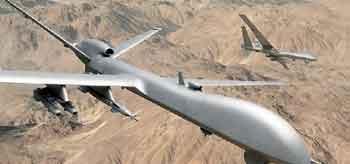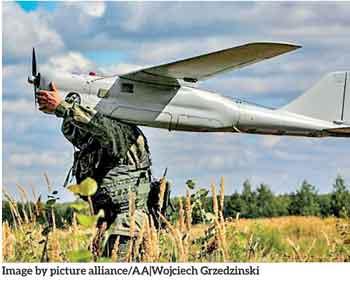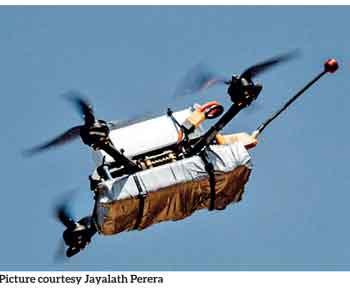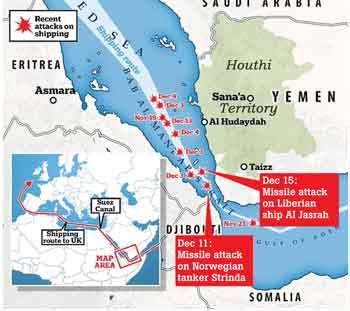23 Jan 2024 - {{hitsCtrl.values.hits}}


“Commercial drones do increase the risk to national security” reflects a concern shared by many security experts, and governments. The capabilities of both state and non-state actors in the realm of drone warfare can indeed pose challenges to national security, and commercial drones play a significant role in this background.
“A fleet of drones that are available online for as little as $6,500 filled the skies above Israel’s $1 billion border fence.” The cheap and makeshift drones used by the Palestinian Resistance Movement Hamas have posed a significant challenge to Israel’s High Technology, posing a threat to some of the most technologically advanced powers in the world, Bloomberg has revealed. “It wasn’t the eruption of rocket fire from Gaza that rattled soldiers at Israel’s southern frontier on Oct. 7. It was the unusual hum overhead that they hadn’t heard before,” Bloomberg wrote. According to the New York-based news website, “a fleet of drones that are available online for as little as $6,500 filled the skies above Israel’s $1 billion border fence.” “They were rigged to carry explosives and knock out cameras, communications systems and remote-controlled guns”. Moreover, Israel’s Iron Dome system has been upgraded to detect large UAVs, but “many Hamas drones are still able to slip through.” According to the New York-based news website. Therefore, the hightech surveillance systems were not able to prevent Hamas’ military operation.
(The Palestine Chronicle) https://www.palestinechronicle.com/hamasmakeshift-drones-are-outsmarting-israels-technology-bloomberg/
Evolutionary trends in pilotless aircraft need to be identified and put in context. Instead of focusing on trends in the technical development of pilotless aircraft, that is tracked through its various manifestations over time. Since unmanned aerial vehicles (UAVs) are often included in the ongoing revolution in military affairs, they are seen as a new concept, created for the age of “information warfare” and “net-centric operations.” Rather than being a new and revolutionary idea, pilotless aircraft are a tried and true branch of military research and development. Revolution in Military Affairs (RMA) is a hypothesis in military theory about the future of warfare, often connected to technological and organizational recommendations for military reform.
Drones in warfare are primarily used for surveillance, intelligence gathering, propaganda, and strikes. Surveillance and reconnaissance are the most natural uses of drones. All drones carry photo, video, or other data collection sensors, which allow forces to locate enemy bases, observe troop movements, and choose targets.
 Today the multifaceted nature of UAVs and the diverse ways in which they are employed by both state and non-state actors. Real-time intelligence gathering, precision targeting, and lethal capabilities contribute to the widespread adoption and interest in UAV technology.
Today the multifaceted nature of UAVs and the diverse ways in which they are employed by both state and non-state actors. Real-time intelligence gathering, precision targeting, and lethal capabilities contribute to the widespread adoption and interest in UAV technology.
Many countries continue to develop UAVs with multiple capabilities. Developed products of various UAV capabilities are freely available in the market. Now it is apparent that non-state actors’ use of UAVs to spread fears, could possibly be extended to chemical or biological attacks, dangerously transporting illicit cargo with limited exposure, or to cause any other desired reaction which will threaten national as well as regional security.
Countering the Drone Threat
 The continued growth of the consumer drone market presents new challenges for the aviation industry. Whether it’s a careless amateur pilot or a deliberate attack, the drone threat comes in many shapes, sizes and forms. Let’s focus on what’s currently available on the market. So, if you need to implement or are thinking about implementing a counter-drone solution, then this is the resource for you. Let’s review the best counter-drone technology, including a helpful breakdown of the pros and cons of each solution. For ease of explanation it is split into two categories; Monitoring equipment and countermeasures.
The continued growth of the consumer drone market presents new challenges for the aviation industry. Whether it’s a careless amateur pilot or a deliberate attack, the drone threat comes in many shapes, sizes and forms. Let’s focus on what’s currently available on the market. So, if you need to implement or are thinking about implementing a counter-drone solution, then this is the resource for you. Let’s review the best counter-drone technology, including a helpful breakdown of the pros and cons of each solution. For ease of explanation it is split into two categories; Monitoring equipment and countermeasures.
What is counter-drone technology?
Counter-drone technology encompasses a wide range of solutions that allow you to detect, classify, and mitigate drones and unmanned aerial vehicles. This includes everything from camera systems and specialist drone detection radar to net guns and cyber takeover systems. Drone Monitoring Equipment could be passive or active and can perform several functions, including Detection, Classification or Identification, Locating and Tracking and Alerting. It is important to be aware that not all equipment performs all the above functionality at the same time. Detection means the technology can detect drones. Detection alone usually isn’t enough though. A radar that detects drones may also detect birds, for example. That’s why classification is useful.
Technology that classifies drones will usually be able to separate drones from other types of objects-like planes, trains, and automobiles, for example One step further is identification. Some equipment can identify a particular model of drone, or even identify the drone’s or controller’s digital fingerprint. This level of identification can be handy for prosecution purposes.
Being alerted that a drone is present somewhere in the vicinity is already useful. But, your situational awareness and ability to deploy countermeasures are greatly enhanced if you know  the drone’s exact location. Some equipment will even allow you to track the drone’s location in real time. There are four main types of drone monitoring equipment: Radio Frequency (RF) Analyzers, Acoustic Sensors (Microphones), Optical Sensors and Radar.
the drone’s exact location. Some equipment will even allow you to track the drone’s location in real time. There are four main types of drone monitoring equipment: Radio Frequency (RF) Analyzers, Acoustic Sensors (Microphones), Optical Sensors and Radar.
State Actors, such as the United States, China, and Russia, have invested heavily in the development of sophisticated drone technology using Advanced Technology. This includes unmanned aerial vehicles (UAVs) with advanced sensors, long endurance, and precision strike capabilities.
In the realm of drone warfare, Stealth and Survivability are important factors. Some state actors have developed stealth drones that are designed to operate in contested environments without being easily detected by enemy radar systems. Swarm Technology is another aspect of the application, exploring the use of drone swarms, where multiple drones operate collaboratively to achieve a common objective.
Use of drone swarms
Drone swarms are used in the military for reconnaissance missions, surveillance operations, and targeting enemy troops or installations, serving as a deterrent in an armed conflict.
Non-state actors, use commercially available Drones that include terrorist groups and insurgent organizations, and have been known to use drones for reconnaissance and surveillance purposes. These drones are often repurposed for their needs.
 ‘Do It Yourself’ (DIY) Drones that are used by some non-state actors have demonstrated the ability to build their own improvised drones for various purposes, including carrying small payloads for attacks. DIY drones are made out of local materials. Non-state actors typically have more Limited Range and Payload limited resources, resulting in drones with shorter range and less sophisticated payloads compared to those used by major military powers.
‘Do It Yourself’ (DIY) Drones that are used by some non-state actors have demonstrated the ability to build their own improvised drones for various purposes, including carrying small payloads for attacks. DIY drones are made out of local materials. Non-state actors typically have more Limited Range and Payload limited resources, resulting in drones with shorter range and less sophisticated payloads compared to those used by major military powers.
Counter-Drone Technology
Many countries and organizations are investing in counter-drone technology to protect against the threat of malicious drone use. This includes systems for detection, tracking, and mitigation. Also, adversaries employ electronic warfare techniques to disrupt or disable drones. This involves jamming communications or even hacking into the drone’s control systems.
Further countries are developing and implementing legal frameworks to regulate the use of drones, especially in sensitive areas. This includes no-fly zones, registration requirements, and other measures to prevent unauthorized drone activity.
It’s essential to stay updated on the latest developments in drone technology, as this field is rapidly evolving, and new capabilities are regularly introduced.
Additionally, the ethical and legal implications of drone warfare continue to be subjects of international debate
and consideration.
Drones in Ukraine and beyond: Everything you need to know
 The Ukrainian battlespace features the most intensive use of drones in a military conflict in history, marking a shift in warfare tactics and technology. Drones have been around for a long time -a very long time, if you go back to Chinese fire kites or the Austrian attack on Venice using exploding balloons in 1849. In addition, Drones were used in Vietnam, in the Kosovo war, Afghanistan, Iraq, and, most recently, in the confrontation between Armenia and Azerbaijan in Nagorno Karabakh.
The Ukrainian battlespace features the most intensive use of drones in a military conflict in history, marking a shift in warfare tactics and technology. Drones have been around for a long time -a very long time, if you go back to Chinese fire kites or the Austrian attack on Venice using exploding balloons in 1849. In addition, Drones were used in Vietnam, in the Kosovo war, Afghanistan, Iraq, and, most recently, in the confrontation between Armenia and Azerbaijan in Nagorno Karabakh.
The ongoing war in Ukraine is thus not “the first drone war”. It is neither the first war in which drones play an important role nor the first in which both sides employ them. Nevertheless, the use of drones in Ukraine represents a step change. Never before have so many drones been used in a military confrontation.
The Royal United Services Institute estimates that Ukraine is losing 10,000 drones per month, giving an indication of how many are in use. Aerial Defence systems are largely neutralizing manned aviation, making unmanned systems particularly important. For those looking to understand their importance, here are the main takeaways from Ukraine. There have been different drone systems in use in Ukraine. These range from the very small – such as the Black Hornet which has a wingspan of only 12 centimeters – to drones with wingspans of over 15 metres. Small systems play a particularly important role in Ukraine.
Quadcopters and other rotor drones are mainly produced by commercial firms such as the Chinese DJI and are among the most common. Armed systems, such as the Turkish-made Bayraktar TB2, or on the Russian side, the Orion drone, carry missiles which can be used to attack troops on the ground. Socalled kamikaze drones, or loitering munition, single-use drones, which hover above a target before diving into it and exploding with it, are also used extensively, especially by Russia but more recently for the attacks on Moscow.
Kremlin Attack
 On 3 May 2023, amidst the ongoing Russian invasion of Ukraine, two explosive drones allegedly targeted the Kremlin in Moscow and were shot down. The Kremlin accused Ukraine of perpetrating the incident and called it an “act of terrorism” and an assassination attempt. Ukrainian officials denied involvement, while U.S. officials said it was likely that a Ukrainian intelligence or special military unit was behind the attack.
On 3 May 2023, amidst the ongoing Russian invasion of Ukraine, two explosive drones allegedly targeted the Kremlin in Moscow and were shot down. The Kremlin accused Ukraine of perpetrating the incident and called it an “act of terrorism” and an assassination attempt. Ukrainian officials denied involvement, while U.S. officials said it was likely that a Ukrainian intelligence or special military unit was behind the attack.
https://en.wikipedia.org/wiki/Kremlin_drone_attack#:~:text=On%203%20May%202023%2C%20amidst,Moscow%20and%20were%20shot%20down.
Surveillance and reconnaissance are the most natural uses of drones. All drones carry photo, video, or other data collection sensors, which allow forces to locate enemy bases, observe troop movements, and choose targets. Closely linked to surveillance is the ability of drones to document attacks, which can also provide useful material for propaganda purposes.
Drones have documented the destruction of cities by Russian forces, the flooding of Ukrainian territory following the Kakhovka dam breach, and attacks against Russian ships, tanks, troops, and materiel. Finally, drones are used to help direct and conduct strikes. At the beginning of the war, Ukrainian forces used armed military drones such as the TB2 to target the Russian convoy headed for Kyiv. A TB2 drone may also have been used to distract the defences of the Russian flagship Moskva while naval missiles attacked and ultimately sank it. Intelligence gathered by drones is also used to direct artillery and other strikes.
Many, possibly the majority, of the drones used by Ukrainian forces were originally designed for commercial purposes or for hobbyists. Drone attacks on Moscow are a warning signal for now – but could eventually have
military consequences.
Initially, unmanned systems were used to attack military installations in Russia, such as the Engels air bases in December. More recently, there have been drone attacks on Moscow, including its financial center,which could have been carried out either by the Ukrainian armed forces or pro-Ukrainian groups possibly from within Russia. Militarily, their impact has been limited, so far, no one has been killed in the attacks and the destruction appears minimal. But a signal has been sent to the Russian regime, population, and businesses that the war could come back to Russia. While Russian air defences reportedly intercepted some of the drones, it is still embarrassing for the Russian military that they are unable to protect the capital. If the attacks continue and grow in frequency and force, the Russian army may have to increase the protection of Moscow and other cities, meaning aerial defence systems or experts might have to be withdrawn from the frontline.
Naval drones are beginning to play a role in Ukraine.
The term “drone” doesn’t necessarily refer to airborne systems, but most drones fly. Maritime drones – both surface vessels and submarine systems – exist, as well as ground-based drones though it is also called robots rather than drones.
Before this conflict, however, only airborne systems were used extensively in military operations. This is starting to change. Drone boats were already used recently, most notably in the attack on Russia’s Black Sea Fleet in Sevastopol. More recently, Ukrainian forces damaged a Russian amphibious landing ship and struck a Russian fuel tanker using naval drones. These attacks are a testimony to Ukraine’s innovative military-industrial sector.
Ukraine is likely to become a serious player in the drone industry once the war ends. Ukraine has become an important place for drone development and manufacturing. Joint private-public partnerships have led to the development or repurposing of drones for military use. The pressure of the war to innovate, the ingenuity of the Ukrainian people, and the opportunity to work closely with experts from many Western countries have helped establish a robust domestic defence industrial base. The Ukrainian drone industry is on track to become a serious international player once the war ends, able to export systems that are combat-proven. The Ukrainian battlespace features the most intensive use of drones in a military conflict in history, marking a shift in warfare tactics and technology. To address these concerns, many countries are working on implementing or enhancing regulations related to drone usage, including registration requirements, nofly zones, and the development of counter-drone technologies. Additionally, there is a growing emphasis on international cooperation to establish norms and standards for responsible drone use to mitigate potential security threats.
Drones are easy targets but that doesn’t mean they are easy to fight.
Drones are easy targets as they are usually not built to evade aerial defences. They tend to fly low and slowly, and can often be destroyed with a single hit.
The key is to integrate security practices into the development lifecycle and maintain a proactive stance towards addressing potential risks/challenges. It is important to understand that the landscape of the realm of Drone warfare is dynamic, technological, regulatory, and market changes are ongoing
However, combatting drones can be difficult as one needs to have the right drone defense systems in the right place, at the right time, while not spending significantly more money on fighting a drone than the drone is worth. There are two main ways to down a drone – kinetically and electronically. The first means shooting down a drone with bullets, rockets, or similar. The second means jamming or interrupting the signal between the drone and its operator. A more advanced version of this approach is to hack the drone and take over its command. The counter-drone market is a multibillion business opportunity.
Drone Countermeasure Equipment
In general Countermeasures can be grouped as either: Physically destroying the drone, Neutralizing the drone, and Taking control of the drone. It’s important to note that, although the technology is available, current regulations in most countries forbid the use of any of the technologies to neutralize drones. Exceptions are sometimes made for military or law enforcement agencies.
GPS spoofing
GPS spoofing is when a counterfeit radio signal is transmitted to a receiver antenna to counteract and override a legitimate GPS satellite signal. It is often a form of cyberattack perpetrated by bad actors attempting to steer goods or people off course. By dynamically altering the GPS coordinates in real time, the spoofer can control the drone’s position. Once the spoofer gains control, they can direct the drone to a ‘safe zone’. However, there is a risk of GPS spoofers inadvertently disrupting other systems beyond the target drone. Because of the risks, GPS spoofers are primarily used on the battlefield and aren’t as common for civilian operations.
Essential Balance
Nations need to strike a balance between fostering innovation in the drone industry and ensuring robust security measures to prevent misuse. Ongoing research and development in counter-drone technologies are also crucial for maintaining national security in the face of evolving threats that is apparently seen in the two ongoing conflicts in Europe and Gaza.
On 17 January 2024, the Iranian backed Houthi movement attacked the Marshall Islands-flagged, United Statesowned and operated bulk carrier Genco Picardy in the Gulf of Aden. According to the United States military, a one-way suicide unmanned aircraft system struck the Genco Picardy at approximately
8:30 pm Sanaa time.
The attack on the Genco Picardy represented the second in recent days targeting vessels directly linked to America after U.S.-led strikes targeting the Houthis. It also underlined the risks to shipping in the vital waterway amid Israel’s war on Hamas in the Gaza Strip. The Genco Picardy sustained damage, but remained seaworthy and was able to continue its journey.
The trajectory of drone technology points towards a future characterized by transformative advancements in various sectors, including logistics, agriculture, infrastructure, public safety, and environmental monitoring. As drones continue to evolve, they are poised to reshape industries, offering innovative solutions to longstanding challenges and unlocking new possibilities for efficiency, precision, and data-driven decision-making. Autonomous capabilities, swarming technology, and improved artificial intelligence are expected to play
pivotal roles in expanding the scope and applications of drones, while ongoing efforts in regulation and safety will be crucial in fostering responsible integration into our daily lives. The use of drones is no longer limited to the military sector. Nowadays, drones are being widely used in other key applications of Entertainment, Law Enforcement, Wildlife Monitoring, Weather, Forecast, Agriculture, Disaster Management, Geographic Mapping, Delivery and Shipping. The increase in the use of drones by several end use industries for operational use is anticipated to be the major driving factor for the global UAV drone market growth from 2019-2027.
The author has exercised utmost effort to incorporate open-source information in this conversation, ensuring that security is not compromised. The key is to integrate security practices into the development lifecycle and maintain a proactive stance towards addressing potential risks/challenges. It is important to understand that the landscape of the realm of Drone warfare is dynamic, technological, regulatory, and market changes are ongoing.
Nations must continue developing strategies to address the challenges posed by the evolving landscape of UAV technology. Further, implementing robust regulatory frameworks, investing in counter-drone technologies, and fostering international cooperation to mitigate security risks associated with the use of UAVs by both state and non-state actors.
https://www.washingtonpost.com/world/2024/01/17/houthi-drone-attacksship-gulf-aden/823e4a98-b56b-11ee-b285-0853d4d1b92f_story.html https://simple.wikipedia.org/wiki/Attack_on_the_Genco_Picardy
https://www.robinradar.com/press/blog/10-counter-drone-technologies-todetect-and-stop-drones-today
(The writer is a former Commander of the Sri Lanka Air Force, Ambassador to Afghanistan and President Association of Retired Flag Rank Officer)
25 Nov 2024 9 minute ago
25 Nov 2024 11 minute ago
25 Nov 2024 12 minute ago
25 Nov 2024 20 minute ago
25 Nov 2024 20 minute ago